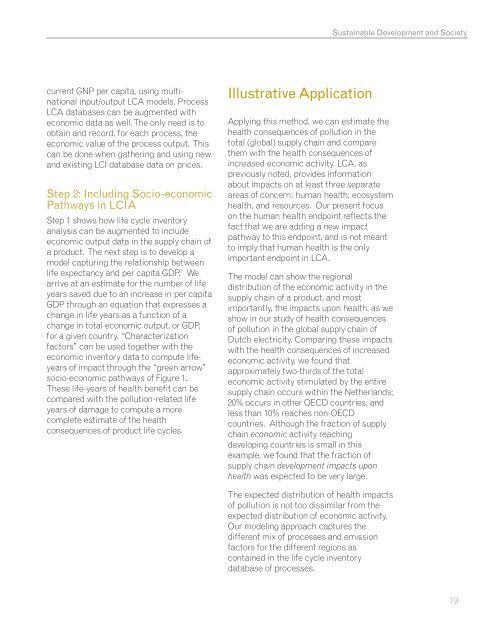Sustainable Development and Society - GSA
Sustainable Development and Society - GSA
Sustainable Development and Society - GSA
You also want an ePaper? Increase the reach of your titles
YUMPU automatically turns print PDFs into web optimized ePapers that Google loves.
<strong>Sustainable</strong> <strong>Development</strong> <strong>and</strong> <strong>Society</strong><br />
current GNP per capita, using multinational<br />
input/output LCA models. Process<br />
LCA databases can be augmented with<br />
economic data as well. The only need is to<br />
obtain <strong>and</strong> record, for each process, the<br />
economic value of the process output. This<br />
can be done when gathering <strong>and</strong> using new<br />
<strong>and</strong> existing LCI database data on prices.<br />
Step 2: Including Socio-economic<br />
Pathways in LCIA<br />
Step 1 shows how life cycle inventory<br />
analysis can be augmented to include<br />
economic output data in the supply chain of<br />
a product. The next step is to develop a<br />
model capturing the relationship between<br />
life expectancy <strong>and</strong> per capita GDP. 7 We<br />
arrive at an estimate for the number of life<br />
years saved due to an increase in per capita<br />
GDP through an equation that expresses a<br />
change in life years as a function of a<br />
change in total economic output, or GDP,<br />
for a given country. “Characterization<br />
factors” can be used together with the<br />
economic inventory data to compute lifeyears<br />
of impact through the “green arrow”<br />
socio-economic pathways of Figure 1.<br />
These life-years of health benefit can be<br />
compared with the pollution-related life<br />
years of damage to compute a more<br />
complete estimate of the health<br />
consequences of product life cycles.<br />
Illustrative Application<br />
Applying this method, we can estimate the<br />
health consequences of pollution in the<br />
total (global) supply chain <strong>and</strong> compare<br />
them with the health consequences of<br />
increased economic activity. LCA, as<br />
previously noted, provides information<br />
about impacts on at least three separate<br />
areas of concern: human health, ecosystem<br />
health, <strong>and</strong> resources. Our present focus<br />
on the human health endpoint reflects the<br />
fact that we are adding a new impact<br />
pathway to this endpoint, <strong>and</strong> is not meant<br />
to imply that human health is the only<br />
important endpoint in LCA.<br />
The model can show the regional<br />
distribution of the economic activity in the<br />
supply chain of a product, <strong>and</strong> most<br />
importantly, the impacts upon health, as we<br />
show in our study of health consequences<br />
of pollution in the global supply chain of<br />
Dutch electricity. Comparing these impacts<br />
with the health consequences of increased<br />
economic activity, we found that<br />
approximately two-thirds of the total<br />
economic activity stimulated by the entire<br />
supply chain occurs within the Netherl<strong>and</strong>s;<br />
20% occurs in other OECD countries, <strong>and</strong><br />
less than 10% reaches non-OECD<br />
countries. Although the fraction of supply<br />
chain economic activity reaching<br />
developing countries is small in this<br />
example, we found that the fraction of<br />
supply chain development impacts upon<br />
health was expected to be very large.<br />
The expected distribution of health impacts<br />
of pollution is not too dissimilar from the<br />
expected distribution of economic activity.<br />
Our modeling approach captures the<br />
different mix of processes <strong>and</strong> emission<br />
factors for the different regions as<br />
contained in the life cycle inventory<br />
database of processes.<br />
19

















